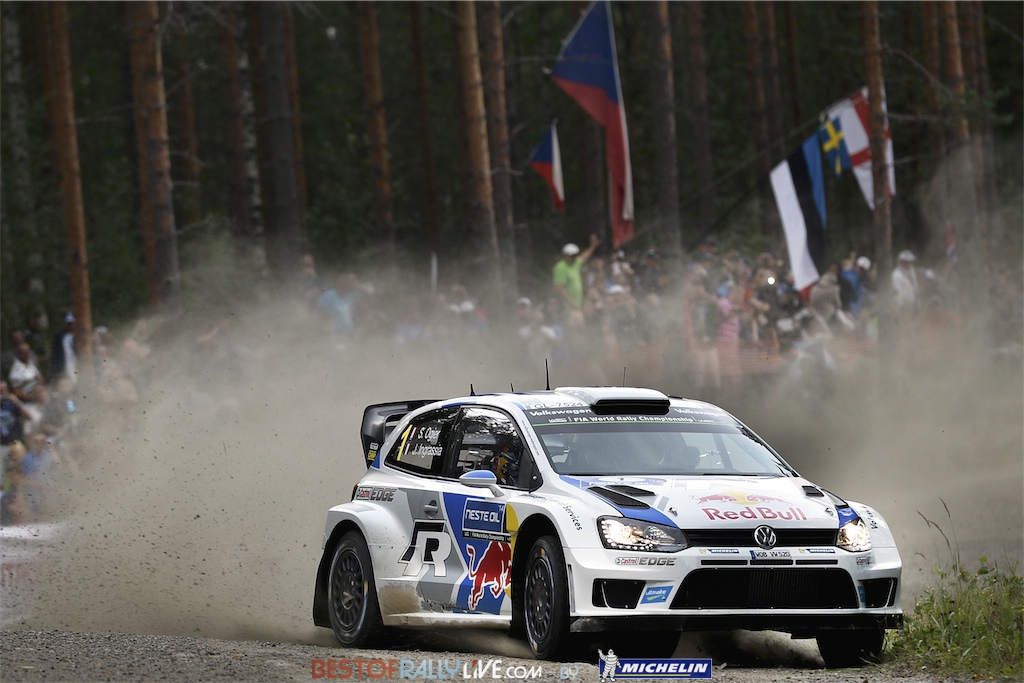Après trois doublés cette saison – Mexique, Argentine, Finlande -, Volkswagen Motorsport compte 175 points d’avance sur Citroën-Total Abu Dhabi au championnat Constructeurs. Or, si le constructeur allemand conclut l’ADAC Rallye Deutschland avec 172 points d’avance sur Citroën, il ne pourra plus être rejoint dans sa quête d’un second titre consécutif. Pour prolonger le suspense, Mads Ostberg et Kris Meeke doivent donc scorer quatre points de plus que Sébastien Ogier et Jari-Matti Latvala en Allemagne.
Sur les huit épreuves disputées cette saison, jamais Citroën-Total Abu Dhabi WRT n’a marqué davantage de points que VW. Mais on se souvient que l’ADAC Rallye Deutschland 2013 avait tourné vinaigre pour l’équipe allemande. Sébastien Ogier était sorti une première fois dans l’ES3, Mittelmosel, puis Jari-Matti Latvala, alors leader, s’était fait piéger sous la pluie de l’ES12, Stein & Wein. Un rallye catastrophique pour VW, et Citroën avait cueilli son 11e succès sur l’asphalte allemand grâce à Dani Sordo à l’issue d’un duel épique avec Thierry Neuville.
Cette année, les deux hommes sont équipiers chez Hyundai Motorsport et feront débuter l’i20 WRC/Michelin sur l’asphalte mondial. Cette « dream-team » sera complétée par le Français Bryan Bouffier, 2e du Monte-Carlo et vainqueur du Rallye d’Antibes (1ère victoire sur asphalte de la Hyundai i20 WRC). La coréenne sera-t-elle au niveau de ses pilotes sur cette surface ?
Question inverse chez Citroën. On sait que la DS3 WRC est une arme redoutable sur les routes du Deutschland, mais Kris Meeke n’a plus évolué sur « pur tarmac » depuis trois ans et Mads Ostberg est plus à l’aise sur terre ou neige. Mais si les conditions météo sont difficiles, les deux hommes sauront tirer bénéfice de l’immense expérience du team…
Des conditions difficiles pourraient aussi profiter aux pilotes M-Sport Mikko Hirvonen, 3e l’an passé, et Elfyn Evans, 2e du classement WRC-2 en 2013 à 12s9 de Robert Kubica. Malgré sa pointe de vitesse sur asphalte, le Polonais se fait peu d’illusions sur ce parcours truffé d’épingles serrées à cause de son handicap au bras droit.
Le parcours 2014 est des plus classiques avec trois profils différents : les routes étroites et escarpées du vignoble mosellan, les pistes bétonnées, abrasives et bordées « d’Hinkelsteins » du camp militaire de Baumholder, et les routes rapides et techniques du Saarland.
Après Cologne l’an passé, l’ADAC Rallye Deutschland 2014 s’élancera de Trèves avec une 2espéciale inédite près de la frontière belge, Waxweiler, (16,40 km) et Moselland (21,02 km) parcourue dans le sens opposé. Samedi, la mythique spéciale de Panzerplatte (42,23 km) a subi quelques modifications mais devrait toujours jouer son rôle de juge de paix. Dimanche, Dhrontal (18,03 km) et Grafschaft (19,27 km) se parcourront en sens inverse. L’arrivée sera jugée devant la Porta Nigra de Trèves.
Thanks in part to its score of three one-two finishes so far this season (in Mexico, Argentina and Finland), Volkswagen Motorsport has pulled 175 points clear of Citroën-Total Abu Dhabi in the provisional Manufacturers’ standings. If the German make succeeds in completing Rallye Deutschland with a cushion of 172 points over its French rival, the fight will be over for 2014. To maintain the suspense, therefore, Mads Ostberg and Kris Meeke will need to pocket 4 more points than Sébastien Ogier and Jari-Matti Latvala in Trier.
That said, Citroën-Total Abu Dhabi WRT has yet to claim more points than VW on the same event this season, but the German round was something of a disaster for the local team in 2013. Ogier crashed on SS3 (Mittelmosel) and Latvala was a victim of the rain while leading on SS12 (Stein & Wein). Citroën went on to collect its 11th victory in Trier thanks to Dani Sordo after a thrilling fight with Thierry Neuville.
This time round, these two drivers will be team-mates at Hyundai Motorsport and the i20 WRC/Michelin will be making its asphalt debut at world level. They will be supported by Frenchman Bryan Bouffier who came second on the Rallye Monte-Carlo before winning the Rallye d’Antibes to notch up the Korean car’s maiden asphalt success…
In contrast, Citroën’s DS3 WRC is a known quantity on Rallye Deutschland’s stages, but Meeke hasn’t competed on ‘clear’ asphalt for three years and Ostberg is traditionally happier on gravel and snow. If the conditions prove difficult, however, they could well benefit from their team’s immense experience of this event.
Poor weather could also play into the hands of M-Sport’s Mikko Hirvonen (third in 2013à and Elfyn Evans (second in WRC-2 12 months ago, 12.9s behind Robert Kubica). Even so, despite his speed on sealed surfaces, the Pole is unlikely to be at ease through the countless hairpins because of his right arm.
The 2014 rally features a conventional format, with a day contesting the steep and narrow stages of the Mosel Valley vineyards, followed by the abrasive, ‘hinkelstein’-lined concrete roads over the Baumholder military ranges and, finally, the faster, more technical Saarland tests.
Last year’s Rallye Deutschland started in Cologne, but the event has reverted to a start in Trier this year, followed by a stage near the Belgian border (‘Waxweiler’, 16.40km) and ‘Moselland’ (21.02km) which will be run in the opposite direction. The legendary ‘Panzerplatte’ (Saturday, 42.23km) has undergone a certain number of changes but is likely to be as challenging as ever. Action will conclude with Sunday’s ‘Dhrontal’ (18.03km) and ‘Grafschaft’ (19.27km), again in the opposite direction to usual.


